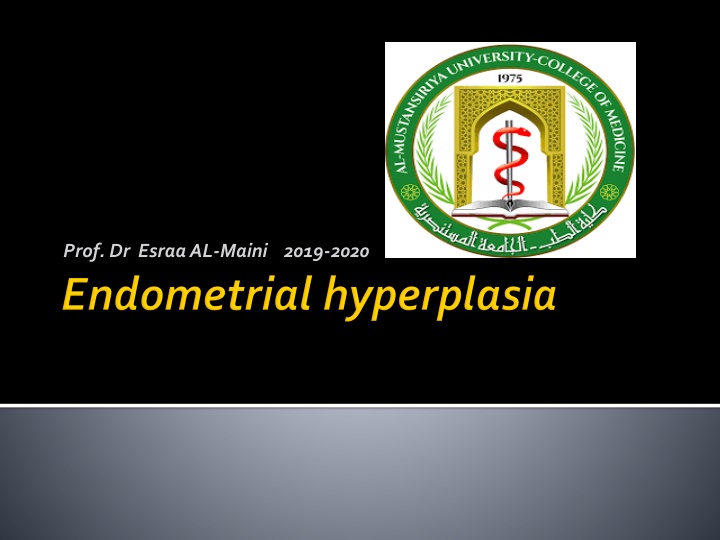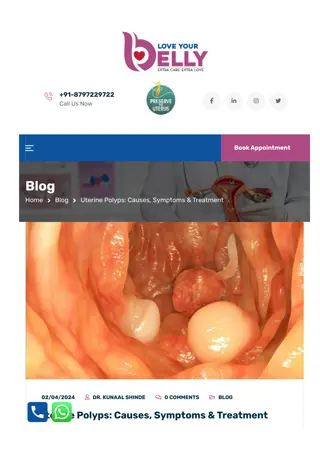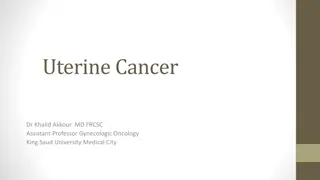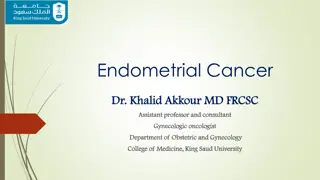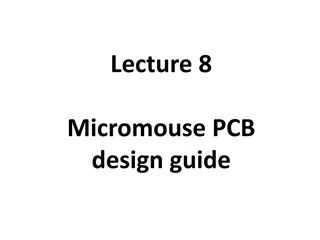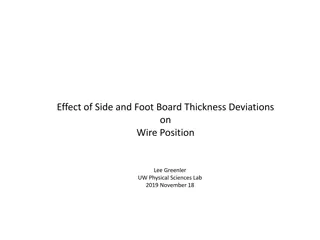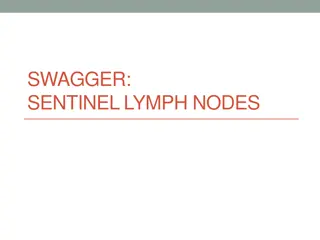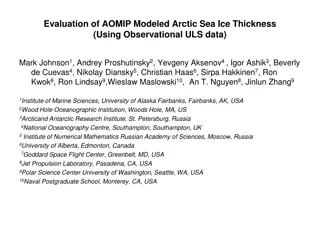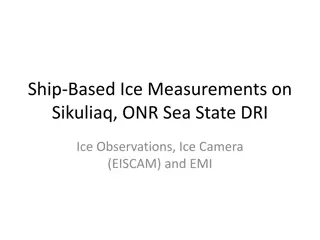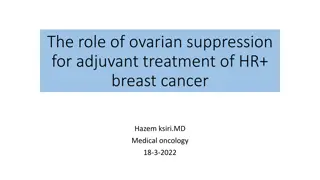Endometrial Thickness in Premenopausal Women
Endometrial thickness in premenopausal women varies throughout the menstrual cycle. Persistent thickness over 12mm should be further evaluated for potential risks, such as endometrial carcinoma. Factors like endogenous and exogenous estrogen, endometrial hyperplasia classification, and risk factors for endometrial carcinoma play essential roles in understanding women's health. Recognizing symptoms like irregular uterine bleeding is crucial for early detection and management of conditions like endometrial hyperplasia and carcinoma.
Download Presentation

Please find below an Image/Link to download the presentation.
The content on the website is provided AS IS for your information and personal use only. It may not be sold, licensed, or shared on other websites without obtaining consent from the author.If you encounter any issues during the download, it is possible that the publisher has removed the file from their server.
You are allowed to download the files provided on this website for personal or commercial use, subject to the condition that they are used lawfully. All files are the property of their respective owners.
The content on the website is provided AS IS for your information and personal use only. It may not be sold, licensed, or shared on other websites without obtaining consent from the author.
E N D
Presentation Transcript
premenopausal women : Endometrial thickness in normal endometrial vary according to day of cycle 4 mm on day 4 of the menstrual cycle 8 mm by day 8.
Persistent endometrial thickness, independent of cycle day, measuring =>12 mm should be further evaluated especially for women those with risk factors for endometrial carcinoma .
A-Endogenous estrogen. The most common cause Chronic anovulationis associated with _The polycystic ovary syndrome(PCOS) _ Ovarian tumor (eg, granulosacell tumor _ Obese women B- Exogenous estrogen.
The World Health Organization classification of endometrial hyperplasia is based upon two factors: 1. Simple or complex glandular/stromal architectural pattern 2. The presence or absence of nuclear atypia
. Endometrial carcinoma is more than 10-fold more likely in atypical hyperplasia (simple or complex).
1-Increasing age 2-Unopposed estrogen therapy 3-Late menopause (after age 55) 4-Nulliparity 5-Polycystic ovary syndrome (Chronic anovulation) 6-Obesity 7-Diabetes 8-Hereditary nonpolyposis colorectal cancer 9-Tamoxifen 10-Early menarche 11-Estrogen secreting tumor 12-Family history of endometrial, ovarian, breast, or colon cancer
Endometrial hyperplasia should be suspected in: 1- Women with heavy, prolonged, frequent (ie, less than 21 days). 2- Irregular uterine bleeding. Abnormal uterine bleeding in perimenopausal or postmenopausal women is the most common clinical symptom of endometrial neoplasia, although such (PMB)bleeding is usually (80%) due to a benign condition.
1-Transvaginal sonography; may have a role in diagnosing endometrial hyperplasia in pre- and postmenopausal women 2-Endometrial biopsy :diagnosis of endometrial hyperplasia requires histological examination of the endometrial tissue. 1-Office biopsy(out patients) 2-D/C biopsy. 3-Hysteroscopic guided biopsy
1-Abnormal -uterine bleeding with risk factors 2-Failure to respond to medical treatment for abnormal uterine bleeding 3-unopposed estrogen replacement therapy 4- Asymptomatic women presence of endometrial cells on Pap smear if they are at increased risk of endometrial cancer 5-Women with hereditary nonpolyposis colorectal cancer
1-Endometrial hyperplasia with atypia by office biopsy, further evaluation by Dilation and curettage (D&C) is needed to exclude a coexistent endometrial adenocarcinoma(% 25) 2. Non diagnostic office biopsy. Endometrial hyperplasia/cancer needs to be excluded in women with a non diagnostic office biopsy. hysteroscopy/directed biopsy 3. Persistent bleeding. After benign endometrial biopsy or treatment of endometrial pathology. hysteroscopy/directed biopsy 4. Postmenopausal women. hysteroscopy/directed biopsy
1- Observation alone The risk of progressing to endometrial cancer is less than 5% over 20 years . The majority o will regress spontaneously during follow-up. Observation alone with follow-up endometrial biopsies to ensure disease regression can be considerd , especially when identifiable risk factors such as obesity and the use of (HRT) can be reversed.
Higher disease regression rate than observation alone. indications: 1-In women who fail to regress following observation alone 2- In symptomatic women with abnormal uterine bleeding. Types of progesterone; 1- Local progesterone ([LNG-IUS]) should be the first-line medical treatment because compared with 2: It has a higher disease regression rate More favourable bleeding profile It is associated with fewer adverse effects. 2-Continuous oral progesterone should be used (medroxyprogesterone 10 20 mg/day or norethisterone 10 15 mg/day) for women who decline the LNG-IUS. Cyclical progestogens should not be used
- Treatment with oral progestogens or the LNG-IUS should be for a minimum of 6 months in order to induce histological regression ,women should be encouraged to retain the LNG-IUS for 5 YEARS this reduces the risk of relapse 1-If adverse effects are tolerable 2-fertility is not desired 3-If it alleviates abnormal uterine bleeding symptoms.
-Endometrial surveillance with outpatient endometrial biopsy should be arranged at a minimum of 6-monthly intervals. -At least two consecutive 6-monthly negative biopsies should be obtained . -Women should be advised to seek a further advice if abnormal vaginal bleeding recurs after completion of treatment because this may indicate disease relapse. In women at higher risk of relapse; -As body mass index (BMI) of 35 or greater Those treated with oral progestogens 6-monthly and endometrial biopsies are recommended Once two consecutive negative endometrial biopsies have been obtained long-term follow-up should be considered with annual endometrial biopsies.
should not first-line treatment because progestogen induces remission in the majority avoids the morbidity Hysterectomy is indicated in women not wanting to preserve their fertility when 1-Progression to atypical hyperplasia during follow-up, 2- No histological regression after 12 months of treatment 3- Relapse of endometrial hyperplasia after completing progestogen 4- Persistence of bleeding symptoms 5-The woman declines to undergo endometrial surveillance or comply with medical treatment
Types of surgery 1- Postmenopausal women should be offered a bilateral salpingo-oophorectomy together with the total hysterectomy. 2- premenopausal women, the decision to remove the ovaries should be individualised; reduce the risk of a future ovarian malignancy. 3- A laparoscopic approach is preferable . 4- Endometrial ablation is not recommended .
1- Total Hysterectomy because of - The risk of underlying malignancy25%, Progression to cancer 25-50% laparoscopic approach - Postmenopausal should be offered bilateral salpingo-oophorectomy - -premenopausal women, the decision to remove the ovaries individualised; but removal will reduce the risk of a future ovarian malignancy. Endometrial ablation is not recommended
2--Women with atypical hyperplasia who wish to preserve their fertility or who are not suitable for surgery Women wishing to retain their fertility should be counselled about the risks Pretreatment investigations should aim to rule out invasive endometrial cancer or co-existing ovarian cancer by TVUS and endometrial biopsy First-line treatment with the LNG-IUS should be recommended, with oral progestogens as a second- best alternative Once fertility is no longer required, hysterectomy should be offered because high risk of disease relapse
followed up TVUS and endometrial biopsy : at 3 months interval until minimum two consecutive negative biopsies are obtained So two negative and asymptomatic women long-term follow-up with endometrial biopsy every 6 12 months is recommended until a hysterectomy is performed.
In women wishing to conceive Disease regression should be achieved on at least one endometrial sample before women attempt to conceive. Assisted reproduction may be considered as the live birth rate is higher and it may prevent relapse.
HRT and endometrial hyperplasia 1- Systemic estrogen-only HRT should not be used in women with a uterus. 2- All women taking HRT should be encouraged to report any unscheduled vaginal bleeding promptly. 3- advised to change to continuous progestogen intake using the LNG-IUS or a continuous combined HRT preparation.
Observation alone Treat with progesteron IUS oral 6m -5years follow up 6m until 2 ve No atypical cell If symptoms recure or high risk so yearly biopsy Hysterectomy not 1st line indicated if Progress ,not regress ,relapse ,poor compliance refuse IUS
Fertility is concern exclude ovarian cancer endometrial before treatment IUS -oral progesterone 3-month follow up biopsy until 2 ve then atypical cell 6-12month biopsy until hysterectomy Hysterectomy 1st line with BSO in Post Menop.
